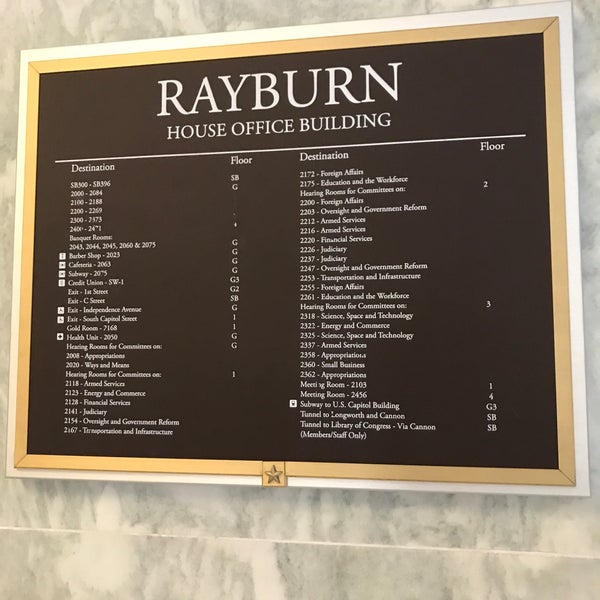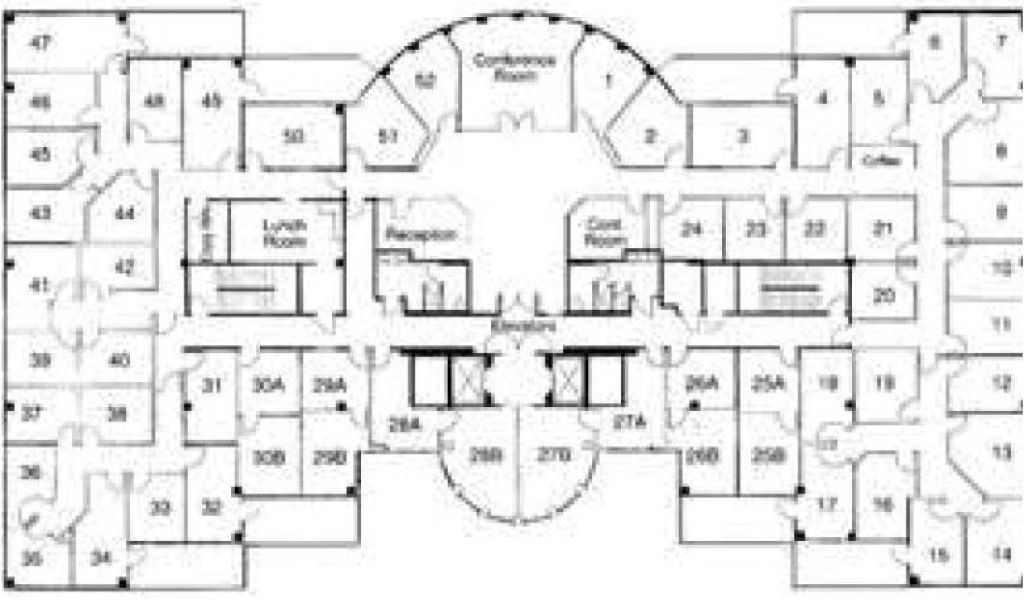Picture this: you're standing in the heart of Washington D.C., surrounded by iconic buildings that shape the course of history. Among these structures is the Rayburn House Office Building, a place where the wheels of democracy turn every single day. This isn't just any office building—it's a powerhouse where lawmakers gather to craft policies that impact millions of lives. If you've ever wondered about its significance, this article dives deep into everything you need to know about the Rayburn House Office Building.
Now, let's face it—D.C. is packed with fascinating landmarks, but the Rayburn House Office Building holds a special place in the grand scheme of things. It's not just about the architecture or the sheer size; it's about the work that happens within its walls. From committee meetings to press conferences, this building is a living, breathing testament to the democratic process.
Before we dive into the nitty-gritty, here's a quick spoiler: the Rayburn House Office Building isn't just a place for politicians to hang out. It's a symbol of collaboration, a hub for decision-making, and a reminder of the importance of civic engagement. Ready to learn more? Let's get started!
Read also:How Old Is Marie Osmond Discover The Queen Of Variety Shows And Her Remarkable Journey
Table of Contents
- A Brief History of the Rayburn House Office Building
- The Building's Architectural Marvels
- What Happens Inside?
- Key Figures Associated with Rayburn
- Visiting the Rayburn House Office Building
- Why It Matters in Modern Politics
- Challenges Faced by the Building
- The Future of Rayburn
- Fascinating Stats and Figures
- Wrapping It All Up
A Brief History of the Rayburn House Office Building
Let's rewind a bit to understand how this iconic structure came to be. The Rayburn House Office Building was officially opened in 1965, named after Sam Rayburn, the longest-serving Speaker of the U.S. House of Representatives. The building was designed to accommodate the growing number of congressional staff and provide a modern workspace for lawmakers. It was a game-changer back then, offering state-of-the-art facilities for an increasingly complex legislative process.
Fun fact: the building was constructed during a time when Congress was expanding rapidly. With more representatives and committees, the need for additional office space became urgent. The Rayburn House Office Building stepped in to fill that gap, becoming the third House office building after the Cannon and Longworth buildings. It was a big deal, and it still is!
How It Fits into D.C.'s Landscape
When you think of Washington D.C., you probably picture the Capitol Building, the White House, and maybe the Lincoln Memorial. But the Rayburn House Office Building plays a crucial role in the city's political ecosystem. Located just a stone's throw from the Capitol, it's part of the larger Capitol Hill complex. This proximity allows lawmakers to move seamlessly between their offices and the House chamber, ensuring that business runs smoothly.
Over the years, the building has undergone several renovations to keep up with technological advancements and changing needs. It's not just about appearances; it's about functionality. The Rayburn House Office Building is a perfect example of how architecture can adapt to serve its purpose while maintaining its historical charm.
The Building's Architectural Marvels
Alright, let's talk about the building itself. The Rayburn House Office Building is an architectural masterpiece, blending functionality with aesthetics. Designed by the architectural firm of Gruen and Associates, it features a modernist style that was all the rage in the mid-20th century. The building spans over 600,000 square feet and houses offices for over 200 members of Congress.
But here's the cool part: the building isn't just about the offices. It also includes committee rooms, hearing rooms, and even a cafeteria. Yeah, you heard that right—a cafeteria! It's not your typical workplace, but it's designed to cater to the diverse needs of its occupants. The layout is thoughtfully planned to facilitate communication and collaboration among lawmakers.
Read also:Unveiling The Truth About Michael Jacksons Vitiligo A Comprehensive Guide
Notable Features
- A spacious atrium that serves as a central meeting point
- State-of-the-art audiovisual equipment in committee rooms
- Underground tunnels connecting to other Capitol Hill buildings
- Art installations and historical exhibits throughout the building
These features make the Rayburn House Office Building more than just a workspace. It's a place where history is made and preserved. And let's not forget the attention to detail in the design—every corner of the building tells a story.
What Happens Inside?
Now that we've covered the basics, let's dive into the heart of the matter: what actually happens inside the Rayburn House Office Building? The building serves as the primary workspace for members of the U.S. House of Representatives. It's where they meet with constituents, draft legislation, and participate in committee hearings. In short, it's the nerve center of legislative activity.
Committee meetings are a big deal here. These meetings are where bills are debated, amended, and voted on before they make their way to the House floor. The Rayburn House Office Building houses several key committees, including the Committee on Appropriations, the Committee on Ways and Means, and the Committee on Energy and Commerce. These committees play a vital role in shaping national policy.
A Day in the Life
Imagine a typical day in the Rayburn House Office Building. Lawmakers arrive early, often before the sun is up, to prepare for a busy schedule. They meet with staff, review briefing materials, and attend committee hearings. Throughout the day, there's a constant buzz of activity—phones ringing, people rushing from one meeting to the next, and the occasional press conference.
And let's not forget the interns! The building is also home to hundreds of interns who assist with everything from research to administrative tasks. They're the unsung heroes of the legislative process, gaining valuable experience while contributing to the work of Congress.
Key Figures Associated with Rayburn
Of course, no discussion about the Rayburn House Office Building would be complete without mentioning the man it's named after. Sam Rayburn was a towering figure in American politics, serving as Speaker of the House for 17 years. Known for his integrity and leadership, Rayburn was instrumental in shaping the modern Congress. His legacy lives on in the building that bears his name.
But Rayburn wasn't the only notable figure associated with the building. Over the years, countless lawmakers have called it home. From Nancy Pelosi to John Lewis, the Rayburn House Office Building has been a backdrop for some of the most significant moments in American history.
Biographical Table
| Name | Title | Years of Service |
|---|---|---|
| Sam Rayburn | Speaker of the House | 1940-1961 |
| Nancy Pelosi | Speaker of the House | 2007-2011, 2019-present |
| John Lewis | Congressman | 1987-2020 |
These individuals have left an indelible mark on the building and the institution it represents. Their stories are woven into the fabric of the Rayburn House Office Building, making it a living monument to democratic ideals.
Visiting the Rayburn House Office Building
So, you're thinking about visiting the Rayburn House Office Building? Good call! It's a fascinating place to explore, especially if you're interested in politics or history. However, there are a few things you should know before you go.
First, you'll need to arrange a tour through your local representative's office. Yep, it's not just a walk-in kind of place. But don't worry—it's worth the effort. The tours are guided by knowledgeable staff who can provide insights into the building's history and significance. Plus, you might even spot a lawmaker or two!
Tips for a Great Visit
- Book your tour well in advance to secure a spot
- Be prepared for security checks—this is a secure facility
- Wear comfortable shoes; there's a lot of walking involved
- Take photos where allowed, but be mindful of restrictions
Visiting the Rayburn House Office Building is more than just a sightseeing trip. It's an opportunity to witness democracy in action and gain a deeper understanding of how our government works.
Why It Matters in Modern Politics
In today's fast-paced world, the Rayburn House Office Building remains as relevant as ever. It's a place where lawmakers tackle some of the most pressing issues of our time, from healthcare reform to climate change. The building serves as a reminder of the importance of bipartisanship and collaboration in solving complex problems.
But it's not just about the work that happens inside. The Rayburn House Office Building also plays a role in shaping public perception of Congress. Its presence on Capitol Hill reinforces the idea that government is accessible and accountable to the people it serves. In an era of increasing polarization, this is more important than ever.
Challenges and Opportunities
Of course, no building is without its challenges. The Rayburn House Office Building faces issues like space constraints and technological limitations. But these challenges also present opportunities for innovation and improvement. As Congress continues to evolve, so too will the building that supports its work.
Challenges Faced by the Building
Let's be real—running a building like the Rayburn House Office Building isn't easy. There are logistical challenges, budget constraints, and the ever-present need for modernization. The building was designed in the 1960s, and while it's been updated over the years, there's still room for improvement.
One of the biggest challenges is accommodating the growing number of staff and interns. With more people working on Capitol Hill than ever before, space is at a premium. The building has responded by expanding its footprint and optimizing its layout, but it's an ongoing process.
Solutions on the Horizon
Luckily, there are plans in the works to address these challenges. The Architect of the Capitol, the agency responsible for maintaining the building, is exploring new technologies and design solutions to make the Rayburn House Office Building more efficient and sustainable. These efforts will ensure that the building remains a vital part of the legislative process for years to come.
The Future of Rayburn
Looking ahead, the Rayburn House Office Building is poised to continue its role as a hub of legislative activity. As Congress adapts to new challenges and opportunities, the building will evolve alongside it. This might mean incorporating more green technologies, improving accessibility, or even expanding its footprint.
One thing is certain: the Rayburn House Office Building will remain a symbol of democracy and civic engagement. It's a place where ideas are born, laws are made, and history is written. And as long as democracy thrives, the Rayburn House Office Building will be there to support it.
What to Expect
- Increased use of digital tools to streamline operations
- Enhanced security measures to protect occupants
- Improved sustainability features to reduce environmental impact
The future of the Rayburn House Office Building is bright, and it's exciting to think about the possibilities. Who knows what the next 50 years will bring?
Fascinating Stats and Figures
Numbers don't lie, and when it comes to the Rayburn House Office Building, there are some pretty impressive stats to share. Did you know that the building houses over 400 offices? Or that it hosts thousands of visitors each year? Here are a few more fun facts to sink your teeth into:
- The building spans over 600,000 square feet
- It has 12 committee rooms and numerous hearing rooms
- Over 200 members of Congress have offices in the building
- The cafeteria serves thousands of meals each week
These numbers paint a picture of a bustling, dynamic workplace that's


